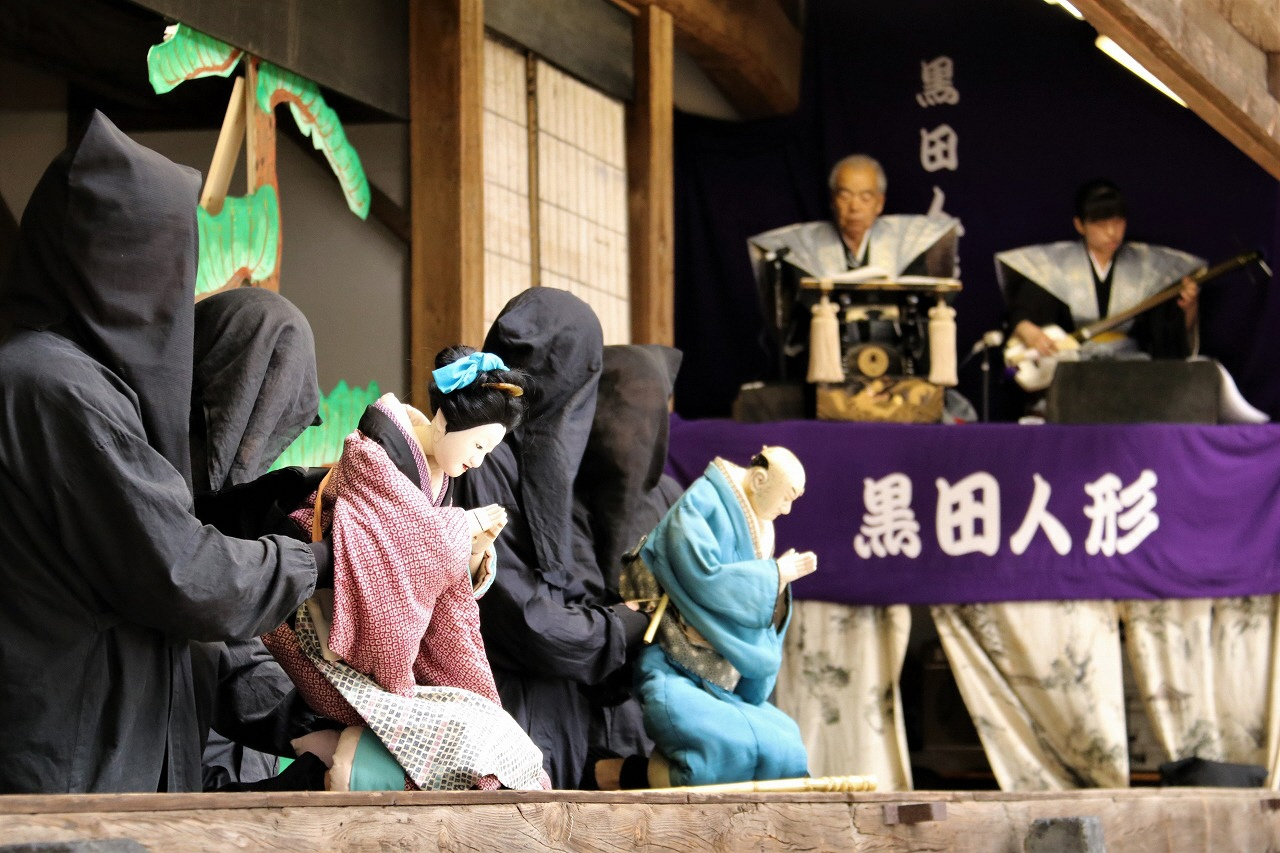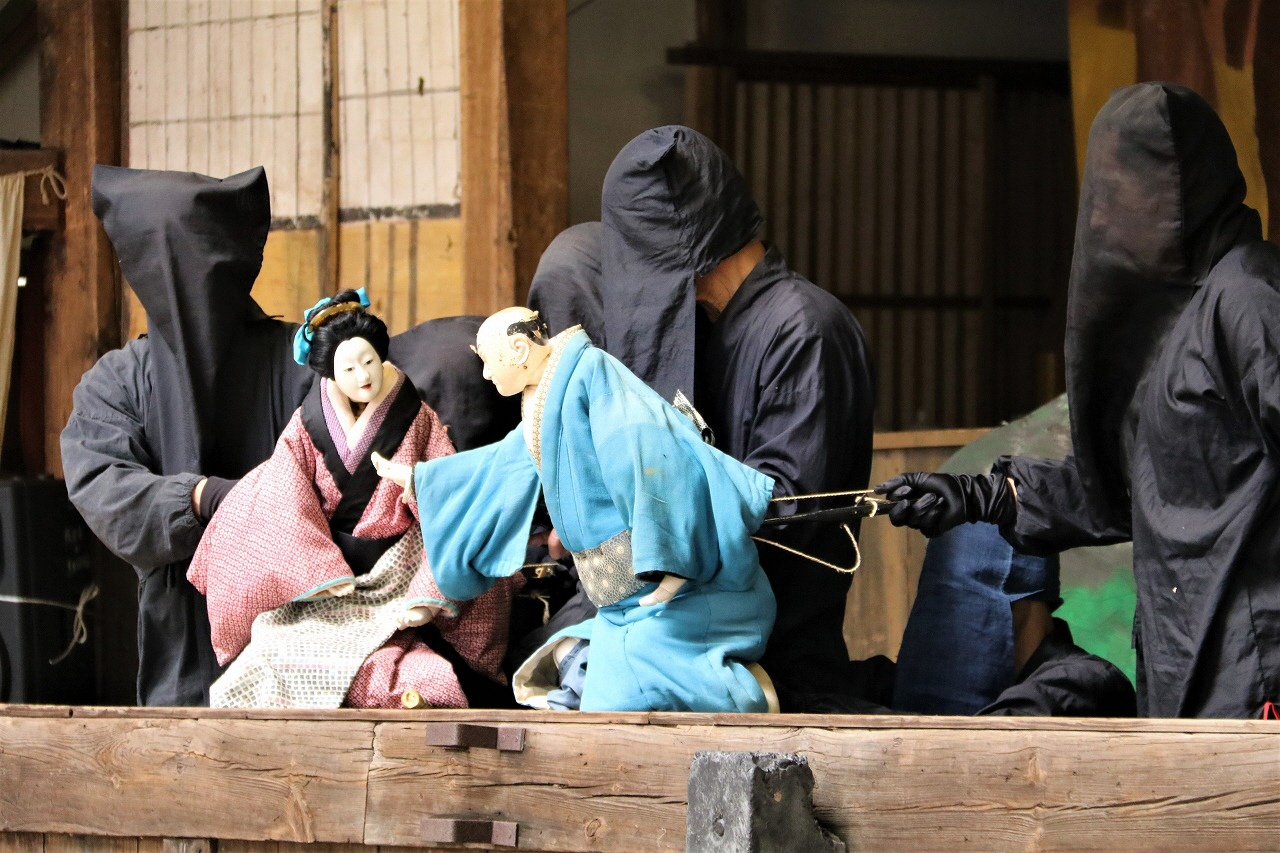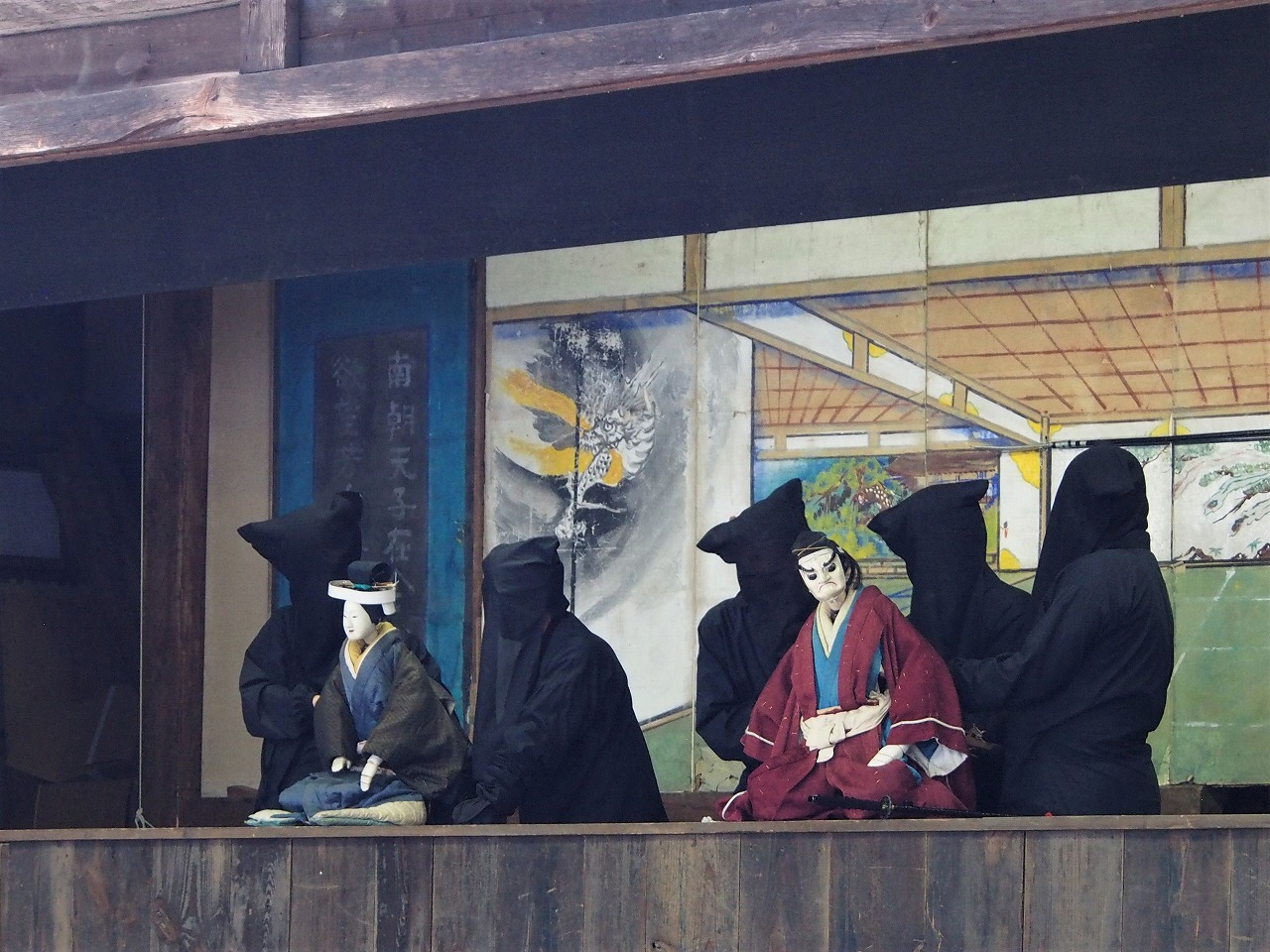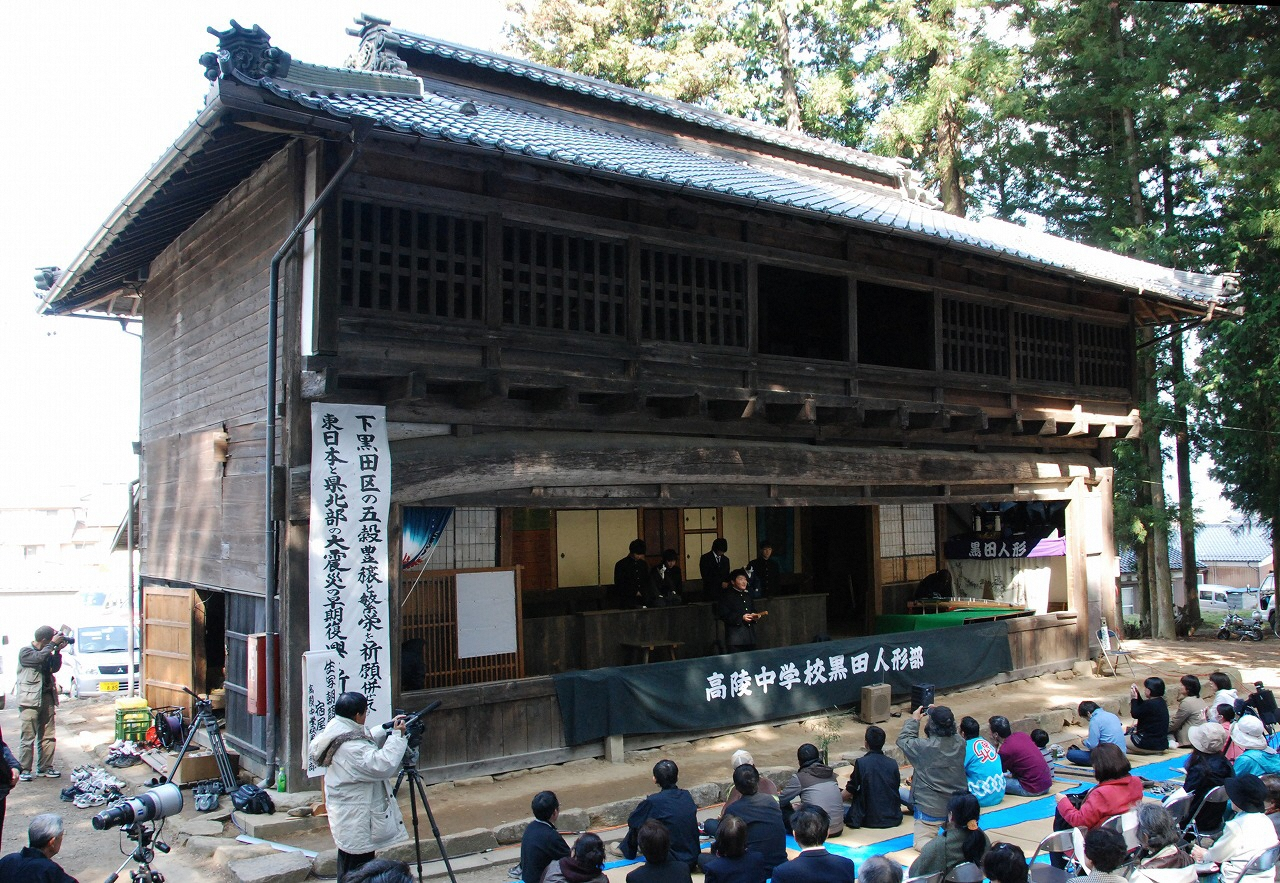本文
kuroda puppet play
Kuroda puppet play
Kuroda puppet play
Division : Iida city Intangible Cultural Property (appointed on 18th February hesei 6 (1993))
"Kuroda Puppet" selected Intangible Folk cultural property by Nagano prefecture
Location: Iida city Kamisato Kuroda 2155

Overview:
It is a three- person operation(*1) of the puppet Joruri (*2).
According to the record of Kuroda’s Suwa shrine, it is said that the one-person manipulation of the puppets revolves to the Genroku era (1688-1703), making it the oldest puppet troupe of Ina Valley. The current style of three-person manipulation was  performed for the first time in Osaka in Kyoho 19 (1734), and it is believed that it was eventually brought to the Ina valley via the highway, making it possible for professional puppet shows to be held in various places. From the Bunsei era (1818-1830) to the 30’s of Meiji era, it has an history of masters such as the puppeteer Yoshida Juzaburo from Awaji and the puppeteers Kiritake Monzaburo, Yoshida Kamezo and Yoshida Kingo from Osaka.
performed for the first time in Osaka in Kyoho 19 (1734), and it is believed that it was eventually brought to the Ina valley via the highway, making it possible for professional puppet shows to be held in various places. From the Bunsei era (1818-1830) to the 30’s of Meiji era, it has an history of masters such as the puppeteer Yoshida Juzaburo from Awaji and the puppeteers Kiritake Monzaburo, Yoshida Kamezo and Yoshida Kingo from Osaka.
What is particularly noticeable about Kuroda puppet is within its puppet manipulation techniques such as the Sanbaso(*3), almost 30 old techniques called "hand" have been transmitted. It is said that these techniques were taught by a master from Awaji and Osaka, it might be valuable lost ancient techniques which cannot be seen in today’s Bunraku(*4).
Kuroda puppet possesses 100 Kashiras, one of them the "fuke oyama’s kashira" dates back to Genbun 2 (1737) and bears the oldest signature of puppet Kashira in japan, it was appointed as Iida city’s folk cultural property.
As well, the "Shimo Kuroda stage" where puppet theater is performed which was rebuilt in Tenpo 11 (1840) for a total of 2 stairs with a width of 8 ken(*5) and a depth of 4 ken, was appointed as an important tangible folk cultural property by the government as it is the oldest and biggest stage dedicated to puppet theater of the country.
Ina’s Puppet Theater including Kuroda Puppet, Imada Puppet (Iida City Intangible Cultural Property) and Waseda Puppet Theater (Shimoina district, Anan town), was selected by the government as intangible folk cultural property that should be documented.
*1 Three-person operation of the puppet: It is a method of manipulation in which three people become one body. The Omozukai manipulates the head and right hand, the Hidarizukai the left hand and the Ashizukai the legs.
*2 Joruri: It is said to be narrative theatrical music in which a Tayu speaks the characters lines and narrates the story, accompanied by shamisen.
*3 Sanbaso: It is a celebratory performance at the beginning Kabuki and Puppet Joruri, it originally is a dance to pray for a bountiful harvest and include an action of stepping on one’s feet.
*4 Bunraku: The Joruri performed by the bunraku troupe created by Uemura Bunrakuken from Awaji, has been designated as an Important Intangible Cultural Property of Japan and registered as a UNESCO Intangible Cultural Heritage (known as World Heritage). According to the Bunraku association, they performed mainly at Osaka’s National Bunraku Theater.
*5 Ken: It refers to the space between the pillars of a building, and is used when referring to the scale of a building. A ken is approximately 1.82m.
Kuroda Puppet’s "Hand"

Each of the puppet manipulation techniques called a "hand" has a name, it has become Kuroda Puppet’s biggest characteristics. There is a fixed pattern for each one of the decisive actions, the way of moving the head, swinging the arms, walking the feet, its combination creates a movement which is unique to Kuroda Puppet.
The hand movements include pointing things "Sashite", indicating wideness "Daimaneki", expressing courage "Norite", etc... The head movements are based on a movement called "Erisuri" and include expressing sadness "Kurizu", expressing hatred "Hikizu", etc... There are various "hands" for crying, laughing, walking such as "Tsume" to intimidate the opponent, "Yumihari" the protagonist’s striking a pose exhibiting full confidence, "Sakibushi" expressing female characters mourning from behind, etc...
These technique forms are said to have been taught by successive generations of masters, and this art once taught by foreign masters has been handed down locally from generations to generations. These forms of puppet manipulation have been handed down in other puppet troupes such as Bunraku but, there are very few examples of so many techniques transmitted with names. Kuroda puppet‘s "hands" are believed to convey the old techniques of Awaji and Bunraku which fastly disappeared.
Play titles
Kuroda puppet have the following plays but, the ones actually performed might differ from time to time.
"The Ceremonial Sanbaso Dance", "Imperial Palace Cherry Blossoms and the Horikawa Night Attack – Benkei the Emissary", "The Nine-Tailed Fox, 2nd act - Michiharu’s Mansion", "The Ridgepole of the Sanjusangendo temple – Heitaro’s House", "The Adachi Plain, 3rd act - Sodehagi’s Appeal", "The Rise of the 1000 Ryô wrestler – At Inugawa’s home", "A Tragedy of Tokushima - The Pilgrim Song", "The Disputed Succession of the Date Family – Masaoka’s Loyalty act", "Ebisu dance", "The Story of Kasane – The Earthen Bridge", "Three Generations of Kamakura- Parting of Miuranosuke with his mother", "The Pattern of Womanhood- The Beating with the Zori Sandal", "A Picture Book of the Taiko Hideyoshi – Amagasaki", "The Story of the Morning Glory – The Inn", "The Miracle of Kannon – Tsubosaka temple", "Clouds of Cherry-Tree Flowers: Dawn in Sakura – At Sogoro’s House", "The Tragic Love Triangle – The Sake Shop", "A Supplement to Chushingura – Honzo’s Villa"
Kuroda Puppet’s history
It is said that during the Genroku era (1688-1703), the monk Seigaku of Shoumei temple(*1) gathered the middle-aged people and taught them. After that a stage of 6 by 3.5 ken was built on the Suwa shrine grounds, they started doing puppet performances instead of the annual Kagura(*2). It is said that large festivals were held during the Horeki (1751-1763) and Nenkan era (1789-1800).
In the Tenpo 11 (1840), the current stage was built in replacement of the old one and its opening festival was held two years later. It was originally planned to last 4 days but on the 3rd day, the Iida council banned the performance due to lack of morals, it was finally allowed again in Koka 2 (1845).
Yoshida Juzaburo, a puppeteer from Awaji, came to Kuroda from the Tenmei (1781-1788) to the Bunsei era (1818-1829) and Kiritake Monzaburo from Osaka came and teached from Tenpo 3 (1832) to Bunkyu era (1861-1863), both of them died here. In the meiji period a puppeteer who lived in Otagiri (Komagone city), Yoshida Kingo, often visited to teach.
Seeking this guidance from foreign puppeteers, Kuroda Puppet was supported by a group called Myojinko and the young people from the district were obliged to join the Shimo Kuroda Branch of the Kamisato Youth Association created in Meiji 26 (1893). The Kamisato Youth Association was dissolved in Showa 20 (1945), but the preservation council was formed in Showa 26 (1951).
*1 The Shoumei temple also known as Takamatsu Yakushi, is located on the north side of Kamisato’slong-term care health facility.
*2 A Kagura is a form of ceremonial music and dance performed during rituals in tribute to a deity.
Tools
They own more than 100 Kashiras which is the most within all of Ina valley’s puppet troupes, 65 of them dates back from the Edo period conveying the tastes of that era. There are many powerful looking pieces for the protagonist while female roles have an elegant expression with plump cheeks.
On the other hand, there are not many ancient hands, legs, body harnesses(*1), costumes, etc... But this is due to reparations and replacements as Kuroda Puppet is still in activity.
*1 The body harness called "douwa" consists of a shoulder plate that forms the shoulder and a waist ring which makes the body, the hands and feet are tied to this body by strings.
Visit-Transport Access
On the 2nd Saturday and Sunday of April, performance dedicated to the Suwa shrine Grand Spring Festival.

- 6 min by car from Iida city area
- JR Iida line "Sakuramachi" "Ina Kamisato" 20 min by walk
Perform at the Iida Puppet Theater Festival starting in August.
Related website – Guidebook
Iidatube.tv (culture hall subsite)(外部リンク)
Heisei 28 (2016) Kuroda Puppet Joruri performance play commentary
"Kuroda Puppet" Nagano Prefecture Iida City Board of Education / Kuroda Puppet Preservation Council 1994

